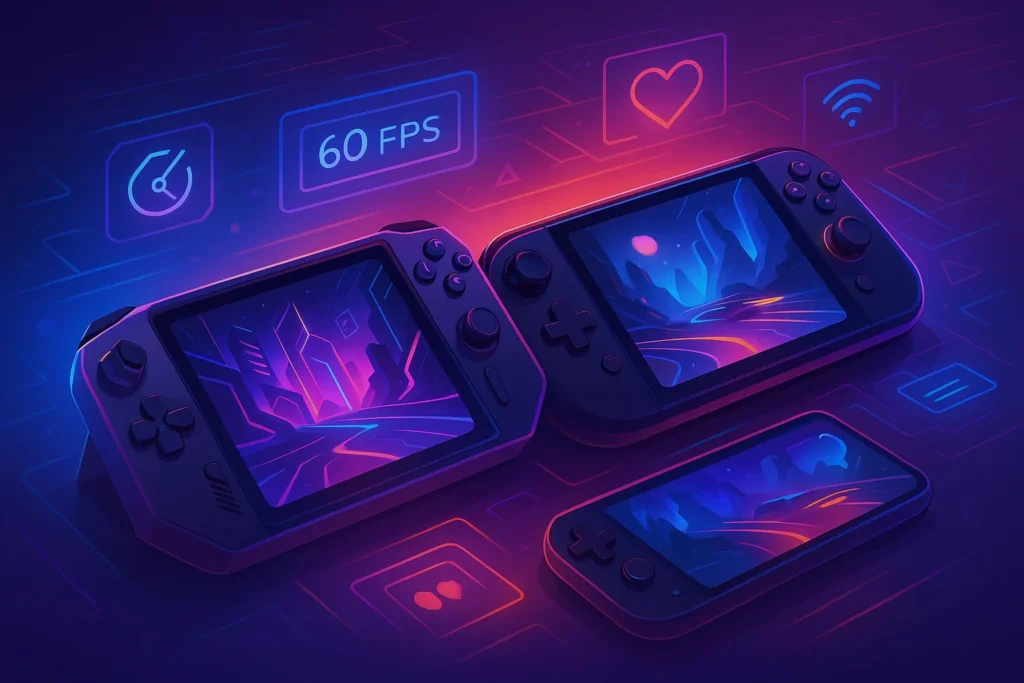Introduction: The Rise of Portable PC Gaming
The handheld revolution is in full swing. What started as a niche market with devices like the AyaNeo and GPD Win exploded when Valve’s Steam Deck proved there was mainstream demand for portable PC gaming. By 2025, this category isn’t a curiosity—it’s a legitimate third pillar alongside desktops and laptops.
ASUS was one of the first major hardware players to respond, launching the original ROG Ally as a Windows-powered handheld alternative. Fast forward to now, the ROG Ally X takes that foundation and refines it, aiming to deliver better battery life, performance consistency, and compatibility across PC ecosystems.
So how does it hold up in real-world gaming, and more importantly, is it a true competitor to the Steam Deck OLED? Let’s break it down section by section.
Design & Build Quality: Comfortable, Durable, Portable
At first glance, the ASUS ROG Ally X feels like a premium piece of kit. The matte finish resists fingerprints better than the glossy plastic of some competitors, and the ergonomics have been noticeably improved over the first ROG Ally. The grips are deeper and more contoured, making it more comfortable to hold for long sessions—something the original model struggled with.
The button layout borrows from Xbox controllers, with offset analog sticks, responsive triggers, and tactile face buttons. ASUS also kept the programmable paddles on the back, which are handy for mapping commands in shooters or MMOs. The overall size is roughly similar to the Steam Deck, but slightly lighter, which helps portability without sacrificing build quality.
Port placement has been improved too, with USB-C ports at both the top and bottom for more flexible charging and docking options. This is a small but meaningful change, especially if you’re gaming while traveling. Durability feels solid—no creaks or flex, and the cooling vents are discreet yet effective.
💡 If you plan on playing in bed or on a commute, the ROG Ally X is easier to handle than bulkier devices thanks to its balanced weight distribution.
Display: Smooth, Bright, and HDR Ready
The 7-inch 1080p display is one of the strongest aspects of the ROG Ally X. It offers a 120Hz refresh rate, which feels silky smooth in fast-paced games like Apex Legends or Rocket League. Compared to the Steam Deck OLED, ASUS opted for an LCD panel rather than OLED, but it compensates with high brightness levels (up to 500 nits) and HDR support, which adds noticeable punch to supported titles.
Color accuracy is excellent out of the box, and the higher refresh rate makes a bigger difference than you might expect on a handheld. Whether you’re scrolling through Windows menus or dodging enemies in Elden Ring, the fluidity elevates the experience beyond standard 60Hz panels.
One limitation is resolution. While 1080p looks sharp on this size screen, some power users might wish for 1440p. But for performance balance and battery life, 1080p is a sweet spot. The screen also supports variable refresh rate (VRR), which reduces tearing in demanding PC titles.
👉 If you’re curious how this compares to Valve’s OLED upgrade, see our Steam Deck OLED Review for Portable Gaming.
Performance: PC Power in Your Hands
The ROG Ally X is powered by a custom AMD APU combining Zen 4 CPU cores with RDNA 3 graphics. In practical terms, this means it can handle most modern AAA games at medium to high settings when locked at 720p or 1080p resolution. In benchmarks, titles like Cyberpunk 2077, Elden Ring, and Horizon Forbidden West ran consistently above 40–60 FPS with tuned settings.
Where the Ally X shines is versatility. Lighter esports titles like CS2, Valorant, and Rocket League easily hit 100+ FPS, which takes full advantage of the 120Hz screen. Emulation is another sweet spot—the Ally X can run PS3 and Switch emulators smoothly, which broadens the library far beyond native PC titles.
Thermals are well managed. The dual-fan system keeps the device cool under load without jet engine noise, a big improvement over the original Ally. ASUS also introduced customizable performance profiles, letting you balance wattage, fan speed, and FPS caps on the fly.
👉 If you’re gaming with friends, pairing the Ally X with titles from our guide to Top PC Games to Play with Friends Online makes the most of its multiplayer versatility.
Battery Life: The Biggest Upgrade
Battery life was the Achilles’ heel of the original ROG Ally, often lasting barely 2 hours in demanding titles. The Ally X addresses this with a larger 80Wh battery, almost doubling endurance. In real-world use:
-
Casual indie games like Hades II or Stardew Valley last 6–7 hours.
-
Mid-range titles like Forza Horizon 5 last 3–4 hours.
-
Heavy hitters like Cyberpunk 2077 drain it in 2.5–3 hours.
That’s still not laptop-level, but a significant step forward in handheld gaming. Fast charging is included, bringing the device from 0% to 50% in around 30 minutes—perfect for quick top-ups between sessions.
💡 Nerd Tip: Locking the display to 60Hz when you don’t need 120Hz can extend battery life by 30–40 minutes without sacrificing much visual quality.
Software & UI: Windows with a Gaming Layer
Unlike the Steam Deck, which runs on Linux-based SteamOS, the ROG Ally X runs Windows 11, making it a full-fledged PC in your pocket. This has pros and cons.
On the plus side, you get immediate access to every launcher—Steam, Epic, Xbox Game Pass, GOG, Battle.net—without hacks or workarounds. You can also run productivity apps, emulators, or even use it as a mini workstation.
The downside is Windows’ clunkiness on small touchscreens. ASUS mitigates this with Armoury Crate SE, a front-end launcher that organizes games, performance profiles, and quick settings in a console-like interface. It works well, but you’ll occasionally be thrown back into standard Windows menus, which feel awkward on a handheld.
👉 Want to know if a handheld PC is worth it for more casual use? Read Is the Steam Deck Worth It for Casual Gamers?.
Compatibility: Play Everything, Everywhere
The biggest selling point of the Ally X is compatibility. It runs everything from AAA Steam releases to Game Pass day-one titles. Unlike the Steam Deck, which sometimes requires Proton compatibility layers, the Ally X plays Windows games natively.
Xbox Game Pass runs flawlessly, making this an excellent Game Pass handheld. Epic Games Store titles are also accessible, and emulation enthusiasts will appreciate smooth performance with Switch, PS2, and PS3 libraries.
This wide compatibility gives the Ally X flexibility no console can match. It’s not just a gaming handheld—it’s your entire PC library in portable form.
Want More Portable Gaming Reviews?
Join our free newsletter for weekly reviews of handhelds, gaming gear, and PC accessories—so you always know where to spend wisely.
No hype. Just real, tested insights.
100% privacy. No noise. Just value-packed gaming reviews from NerdChips.
Accessories & Upgrades: Expand Your Setup
ASUS designed the ROG Ally X to work as both a handheld and a docked PC. With USB-C and third-party docks, you can connect it to a monitor, keyboard, and mouse to turn it into a compact desktop. eGPU (external GPU) support is also available, though it requires ASUS’s proprietary XG Mobile dock for maximum performance—a pricey but powerful option.
Storage is user-upgradable via M.2 SSDs, and expandable via microSD cards. Given how quickly PC games balloon past 100GB, this flexibility is essential. Accessories like portable docks, charging stands, and carry cases round out the ecosystem.
👉 Curious about entry-level setups? See How to Build a Budget Gaming Setup Under $800.
Comparison: ROG Ally X vs Steam Deck OLED vs AyaNeo 2
The handheld PC landscape in 2025 is crowded, but the ROG Ally X positions itself between Valve’s mass-market Steam Deck OLED and boutique devices like the AyaNeo 2.
| Device | Display | Battery | Performance | Price |
|---|---|---|---|---|
| ROG Ally X | 7” LCD, 1080p 120Hz HDR | 80Wh (3–6 hrs) | Zen 4 / RDNA 3 APU | ~$799 |
| Steam Deck OLED | 7.4” OLED, 800p 90Hz | 50Wh (2–5 hrs) | Custom AMD APU | ~$549 |
| AyaNeo 2 | 7” IPS, 1200p 60Hz | 65Wh (2–4 hrs) | Ryzen 7 6800U | ~$1,099 |
The Steam Deck OLED wins on price and OLED visuals, the AyaNeo 2 on premium build and performance, but the Ally X strikes the best balance of battery, screen smoothness, and all-in Windows compatibility.
🎨 Checklist: Who Should Buy the ROG Ally X?
-
Gamers who want a true Windows handheld that runs everything without compatibility hacks.
-
Players who value 120Hz smoothness and HDR more than OLED contrast.
-
Those who need longer battery life than the original Ally or Steam Deck.
-
Enthusiasts who want a portable PC that doubles as a docked mini-desktop.
🧠 Nerd Pick
Thinking about diving into handheld PC gaming?
👉 Get your ASUS ROG Ally X here and unlock a portable library of Steam, Game Pass, and more. Pair it with a dock or portable SSD for the ultimate hybrid setup.
Real-World Use Cases: Where the ROG Ally X Shines
Specs and benchmarks are one thing, but how does the Ally X actually fit into everyday life? For many gamers, this device isn’t a desktop replacement but rather a second system that adapts to different scenarios.
On a long train ride, the Ally X’s lighter weight and improved grips make it easier to hold than bulkier handhelds. Pair it with noise-cancelling headphones and you’ve got a portable entertainment hub for hours. Travelers will especially appreciate the quick-charge feature, which can top the battery up to 50% in just half an hour during a layover.
In a dorm or small apartment, the Ally X works as a console alternative. Plug it into a monitor or TV through a dock, add controllers, and you’re playing local multiplayer with friends. Since it runs Windows, couch gaming can include everything from Rocket League to emulated classics.
For professionals or students, it doubles as a light productivity machine. Writing essays in Word, browsing research, or even video calling through Teams or Zoom works seamlessly. The ability to carry both your Steam library and Office apps in one handheld is a unique edge that consoles can’t replicate.
Thermals & Noise: Keeping Cool Under Pressure
One of the biggest challenges for handheld PCs is heat management. The Ally X uses a dual-fan cooling system with redesigned vents, and it shows. Even when running Cyberpunk 2077 on medium settings, the chassis only gets warm—not uncomfortably hot. The grips remain cool, which makes long play sessions easier than on devices that funnel heat toward the handles.
Noise levels are another win. At max performance mode, you’ll hear a gentle whoosh, but it never reaches laptop “jet engine” levels. In balanced mode, the fans are almost inaudible, especially if you’re using headphones. Compared to the Steam Deck OLED, which has improved fan curves but still ramps audibly under load, the Ally X feels more refined.
This isn’t just about comfort—it’s about performance stability. Cooler chips maintain higher clock speeds for longer, which means fewer frame drops in demanding games. Thermal throttling is less of a concern here, giving the Ally X consistency that handheld gamers have been waiting for.
Community & Modding Angle
One of the hidden strengths of devices like the ROG Ally X is the community that forms around them. Within weeks of launch, you’ll find Reddit threads, Discord groups, and YouTube channels dedicated to unlocking more performance or customizing the experience.
Windows as the base OS means modding and tweaking are almost limitless. You can install fan-control utilities, undervolt for battery savings, or experiment with different overlay software. The community has already started building custom profiles for specific games, balancing FPS targets with wattage for optimal endurance.
Cosmetic mods are also growing—skins, cases, and 3D-printed grips let couples or friends personalize their Ally X units. This DIY culture mirrors what helped the Steam Deck gain traction. ASUS has been smart to embrace it, with forums and Armoury Crate updates that respond to community requests.
If you enjoy tinkering, the Ally X isn’t just a product—it’s a platform.
Streaming & Cloud Gaming: A Hidden Superpower
While much of the hype around the Ally X focuses on native PC gaming, it’s equally capable as a cloud gaming machine. With a stable Wi-Fi 6E connection, services like Xbox Cloud Gaming (xCloud), GeForce NOW, and PlayStation Remote Play all run beautifully.
Cloud gaming is especially useful for preserving battery life. Instead of running Cyberpunk locally and draining the battery in under three hours, you can stream it from the cloud or your home rig and get closer to 6–7 hours of play. Latency is still dependent on your internet connection, but in good conditions, it feels surprisingly close to local performance.
This flexibility is why the Ally X may appeal even to casual players. If you mostly stream games, the device is overkill performance-wise—but it futureproofs your setup if you ever want to dive into native PC titles. For more on cloud options, check out our guide on Best Cloud Gaming Services for Low-End PCs.
Value for Money & Longevity
At around $799, the Ally X costs more than a Steam Deck OLED but less than high-end boutique handhelds like the AyaNeo 2. The question is: does it justify that price?
The answer depends on perspective. If you want the best value per dollar, the Steam Deck OLED is hard to beat. But if you need the widest compatibility, higher refresh rates, and better battery life, the Ally X earns its premium. It’s less a toy and more a long-term investment in portable computing.
Longevity is also stronger than you might think. The Zen 4 CPU cores and RDNA 3 GPU architecture are current-gen, meaning this device should comfortably handle most new releases for the next 3–4 years with smart settings management. The fact that storage is user-upgradable further extends its lifespan.
In short: if you see handheld gaming as more than a side hobby, the Ally X delivers lasting value.
Competition & Ecosystem: The Bigger Picture
No device exists in isolation, and in 2025, the handheld gaming ecosystem is more competitive than ever. Valve’s Steam Deck OLED leans heavily on its integrated SteamOS ecosystem, which provides a console-like simplicity but limits you to Proton compatibility layers. ASUS, on the other hand, bets on Windows and openness, ensuring you can run virtually anything—even if it means living with some UI clunkiness.
Then there are boutique players like AyaNeo and GPD, who push the envelope with high specs but at prices north of $1,000. They attract enthusiasts but lack the brand recognition and distribution that ASUS brings to the table.
Where the Ally X positions itself is smart: premium but not boutique, open but not overwhelming. By tying into Windows, Game Pass, and the massive ASUS ROG brand ecosystem of docks, headsets, and accessories, the Ally X feels less like a gadget and more like part of a larger platform.
If Valve’s approach is about creating a “console-like PC,” ASUS’s strategy is about offering a portable Windows PC that feels console-like when you want it to. That distinction could define the next few years of the handheld war.
🧠 Nerd Verdict
The ASUS ROG Ally X doesn’t reinvent handheld gaming, but it significantly refines it. With a 120Hz HDR display, much-improved battery life, and full Windows compatibility, it strikes a compelling balance between performance and versatility. It’s pricier than the Steam Deck OLED, but if you want a device that plays everything, the Ally X is a strong contender in 2025.
❓ FAQ: Nerds Ask, We Answer
💬 Would You Bite?
If you had to choose today—would you go for the Ally X’s Windows flexibility or the Steam Deck OLED’s affordability and OLED screen?



